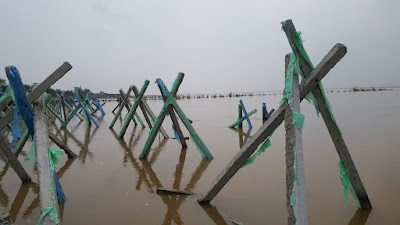 |
| Birds of Koshi Tappu |
Republished from ECS
Are you a bird-watching enthusiast? Then, Koshi Tappu Wildlife Reserve in eastern Nepal is the must-go destination for you. However, when I was there with my friends recently, we ended up discovering more than the birds.
Home to migratory birds and wild water buffaloes
Famous for bird watching, the reserve boasts of being home to more than 485 bird species, especially migratory birds flying from as far away as Siberia. Since we were there in the second week of April, the migratory birds had already left, but we were welcomed by the resident birds. Early in the morning, an Asian koel woke us up with its sweet cuckooing, chorused by coots. Then, as we roamed around the reserve, we spotted black-hooded orioles, swamphen, moorhen, white-rumped vultures, jungle babblers, drongos, flycatchers, doves, rufous treepies, open billed storks, lesser adjutant storks, and a greater adjutant stork, not to mention the different types of wild ducks and so many birds that we couldn't identify. I was simply amazed! Had we had more time, we'd have easily seen the precious Bengal florican in the grassland.
 |
| Arna, the wild water buffalo |
 |
| Arna horns |
As we moved further, we were disheartened by the loud noise coming from a construction site within the core area of the reserve. A part of the reserve had been encroached by scores of construction workers, mixer machines, and tractors, and polluted by construction materials, the high volume of music played by them, and the sound of machines, motors, and vehicles. The reserve authorities could have allocated a piece of land away from the wetland to make the concrete pillars for the biodykes being installed at the banks of the Koshi River, and could have spared the precious habitat of so many birds!
 |
| Noisy construction inside the reserve |
 |
| Dykes at the banks of Koshi River |
Sad fate of dolphins
Once we were done with the bird-watching and moving around the reserve, we set out to meet the reserve officers to inform them of the noisy construction going on inside the reserve. But, when I saw a dead baby dolphin displayed at the reserve's visitor centre-cum-museum, it made me cry. The dolphin was caught in a gillnet in the Koshi River few months ago. It finally died after struggling to survive. And, it's only the tip of the iceberg. Several other dolphins and rare fishes had had similar fates. Sadly, a recent dolphin count in Koshi in 2016 came up with just nine dolphins. Due to over-fishing and destruction of their habitat, their numbers are declining, not to mention the dangerous gillnets that wound them and finally kill them.
 |
| A dolphin that died after getting caught in gillnet |
 |
| Sunflower farming is on the rise in Koshi Barrage area |
On our way back home, we decided to taste the local fishes from the Koshi River. When asked, everybody suggested us to visit Sambhu Hotel by the river. The eatery, established during the East-West Highway construction era, is in a narrow street to the south of the river's eastern banks. You'll never get lost getting here, as everybody in the vicinity knows about it and will happily tell you the directions to the hotel. Once you reach here, you can choose the fish of your choice, which are then cooked by an old man and garnished by the lady who runs the shop with her sons. The fish are sourced from the local fishermen who earn their living by fishing in the river. I bet you'll love the taste and decide to return again and again!
 |
| Fishing in the Koshi River |
 |
| Fishes from Koshi River |
 |
| Shambhu Hotel |
Crossing the barrage, we came across small shanties put up by fishmongers. There were fishes everywhere. The barrage and the surrounding have some special kind of smell wafting around and if you're a fish lover, you'll love it. The fishmongers sell all kinds of fish, including buari, chitalpeti, kanti, tengra, bam, shrimps, and many other local varieties. Among them you can find small fishes growing one-three inches long, called koshia. They taste amazing!
And, finally we waited for the sunset, to capture the silhouettes of cattle on the dam, returning home after grazing in the reserve. It was an out of this world feeling!
Barmajhiyako peda, one of the most delicious sweets produced in eastern Nepal
It was already dark when we left the Koshi Barrage. However, we decided to indulge in a local sweet peda, made from pure milk. You'll find scores of shops selling peda in Barmajhiya, a small town on the way back from Koshi River. They sell the same product and have similar names. And all claim that they're the original shop established by an old man, Baidhyanath Sah. As suggested by the locals, we easily located the 'Budho Baba Peda Pasal', meaning old man's peda shop, adjacent to the Armed Police Force beat. And it happened to be the original one! The shop owner said, "Just look for this banyan tree next to our shop and you'll never fail to recognise our shop." The old man, who left this world a few years ago, started making peda and it became an instant hit among the locals and people visiting eastern Nepal, thanks to the quality of the product. Since then, scores of other shopkeepers have started selling peda, making this place a hub of peda business. But the peda from this original shop has something special about it. It tastes amazing!
 |
| Peda, a delicious sweet made from milk |
No comments:
Post a Comment